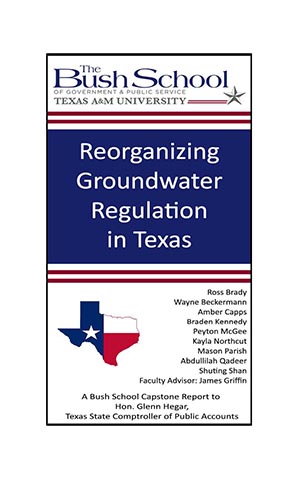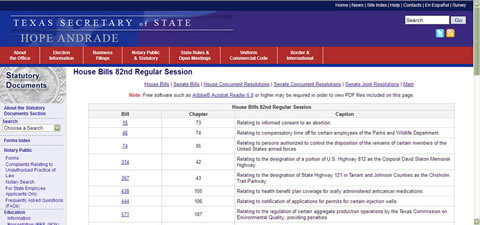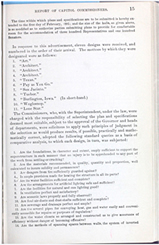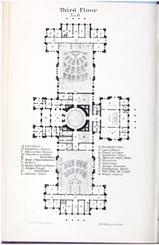 |
Water conservation is a perennial topic in Texas, and a report newly added to our collection this week examines the potential for storing water in underground aquifers, a type of storage known by water experts as aquifer storage and recovery, or ASR. Published by the Texas Water Development Board, the report describes how El Paso Water Utilities, the city of Kerrville, and the San Antonio Water System are utilizing ASR technology.
According to the report, ASR has proven to be an efficient and cost-effective method of storing water compared to the use of surface reservoirs, however Texas is lagging behind other states in the implementation of ASR. It points out that at the present time, less than 4 percent of the nation's operational ASR wellfields are located in Texas, although other fast-growing states such as Florida and California are actively pursuing this technology. The report concludes that the principal challenges for ASR are primarily the legal and regulatory frameworks which, in many states, have not yet caught up with the application of the ASR technology. It points out that although there is a solid regulatory and legal foundation in Texas, improvement and enhancement of the rules and statutes both at the state and local levels are needed. The report makes specific recommendations for legal and/or regulatory changes, and includes several other recommendations that could enhance the implementation of ASR in Texas. |
Week in Review, July 7th
Jul 7
- Review a study of the condition of America's national parks. (National Parks Conservation Association, June 2011)
- Explore financial literacy in American households. (Financial Security Project at Boston College, February 2011)
- See how health insurance costs may continue to rise, especially for small businesses. (Stateline, July 6, 2011)
- Consider how the death penalty has been applied since its reinstatement in 1976. (Death Penalty Information Center, July 2011)
- Check out a state-by-state chart of the effect of cuts to highway infrastructure investment. (Federal Highway Administration, 2011)
- Compare gender differences in how the recession has influenced the job market. (Pew Research Center, July 6, 2011)
The Legislative Reference Library features a number of historically significant paintings and sculptures. Some depict famous Texans, while others highlight less-well known people and incidents from Texas history. Below, we describe works illustrating Texas history during the period of Mexican rule and the Republic of Texas.
 Fort at Nacogdoches (CHA #1989.169) depicts the site of one of the first clashes between colonists and Mexican authorities once Texas was open to settlers in the early 1820s. The government gave a vast land tract near Nacogdoches to an empresario named Haden Edwards. Edwards brought approximately 800 families to this tract in October of 1825 and discovered many people already living within the boundaries of his grant. Although Edwards was required to recognize the rights of those settlers who held legal titles in the area, many of the early settlers did not have titles to their land. Edwards told the settlers to vacate the premises if title was not held, which angered those individuals whose ancestors had lived on the land for decades. These settlers, many whom were Cherokee Indians and Mexicans, wrote letters of protest to the. Mexican government. Political Chief Jose Antonio Saucedo sympathized with the settlers' plight and told Edwards that he could not charge them for new land titles. Edward's brother Benjamin thought this decision unfair and decided to declare the colony independent from Mexico. On December 16, 1826, Benjamin Edwards led a small group of settlers in the taking of the old stone Fort at Nacogdoches. They raised a red and white flag bearing the words "Independence, Liberty and Justice" and proclaimed the creation of the Republic of Fredonia. They received no assistance from Austin's colony or the United States. In late December, the Fredonia Revolt collapsed. A few of the Fredonians were captured, but many escaped across the Sabine River into the U. S. Those who were captured were later released. This incident planted the seeds of concern in the minds of Mexican officials that America was scheming to acquire Texas. This painting is visible in historical photographs of the library as early as ca. 1908–1909.
Fort at Nacogdoches (CHA #1989.169) depicts the site of one of the first clashes between colonists and Mexican authorities once Texas was open to settlers in the early 1820s. The government gave a vast land tract near Nacogdoches to an empresario named Haden Edwards. Edwards brought approximately 800 families to this tract in October of 1825 and discovered many people already living within the boundaries of his grant. Although Edwards was required to recognize the rights of those settlers who held legal titles in the area, many of the early settlers did not have titles to their land. Edwards told the settlers to vacate the premises if title was not held, which angered those individuals whose ancestors had lived on the land for decades. These settlers, many whom were Cherokee Indians and Mexicans, wrote letters of protest to the. Mexican government. Political Chief Jose Antonio Saucedo sympathized with the settlers' plight and told Edwards that he could not charge them for new land titles. Edward's brother Benjamin thought this decision unfair and decided to declare the colony independent from Mexico. On December 16, 1826, Benjamin Edwards led a small group of settlers in the taking of the old stone Fort at Nacogdoches. They raised a red and white flag bearing the words "Independence, Liberty and Justice" and proclaimed the creation of the Republic of Fredonia. They received no assistance from Austin's colony or the United States. In late December, the Fredonia Revolt collapsed. A few of the Fredonians were captured, but many escaped across the Sabine River into the U. S. Those who were captured were later released. This incident planted the seeds of concern in the minds of Mexican officials that America was scheming to acquire Texas. This painting is visible in historical photographs of the library as early as ca. 1908–1909.

Stephen Fuller Austin (CHA #1989.101), the founder of Anglo-American Texas, was born November 3, 1793, in Virginia. After schooling in Connecticut and Kentucky, he returned to his family in Missouri and prepared to work with his father, Moses, to settle 300 Anglo-American families in Texas. After the death of Moses Austin in 1821, however, the younger Austin was left to lead the colonists. During the next 15 years, Austin settled over 1,000 families, surveyed the various terrain and created many early maps of the area, and remained devoted to the development of the land now known as Texas. He wrote in July of 1836 that "The prosperity of Texas has been the object of my labors, the idol of my existence—it has assumed the character of a religion, for the guidance of my thoughts and actions, for fifteen years." He died five months later at the age of 43. Artist Louis Eyth (1838–1889) of Galveston was commissioned in 1873 by Joint Resolution Number 86 to copy the Austin portrait in the Senate Chamber. It was probably painted in 1836 in New Orleans where Austin had traveled as minister to the United States from the Republic of Texas; family records show that Austin had that portrait made for his sister, Emily Bryan Perry, whose grandson, Guy M. Bryan, Jr., later presented it to the State of Texas in 1919. Louis Eyth. ca. 1873, Oil on canvas.

Juan Nepomucena Seguin (CHA #1989.96) was born in San Antonio on October 27, 1806. A friend of Anglo-Americans coming to Texas, he opposed Antonio Lopez de Santa Anna and recruited volunteers against Mexico in the fall of 1835. He and his recruits met Stephen F. Austin in October, fought with James Bowie in the battle of Concepcion, and was active in the siege of Bexar in December. In January he became a captain in the cavalry with orders to report to William B. Travis in San Antonio. He escaped Travis' fate at the Alamo only because he was sent through the Mexican lines with a plea for reinforcements. He later fought in the Battle of San Jacinto with his men and was promoted to lieutenant colonel with orders to take over the military government of San Antonio until the civil government could be restored. He served in the Texas Senate in 1838 where he worked for friendly relations between Mexican-Texans and Anglo-Texans. He was elected mayor of San Antonio in January of 1841 but resigned in April of 1842 amidst allegations of being a traitor for Mexico. He fled to Mexico and was forced to choose between prison and serving in the Mexican Army under Santa Anna. After the signing of the Treaty of Guadalupe Hidalgo in 1848, Seguin was granted permission to return to Texas. He died in Nuevo Laredo in 1889. Jeff Wright, ca. 1838, Oil on canvas.

The Alamo Sculpture (CHA #1994.25) depicts a woman with clasped hands kneeling over a fallen Texan soldier with the caption "Thermopylae had her messenger of death; the Alamo had none." This phrase undoubtedly was coined from either the first or second Alamo Monuments, which commemorate the fall of the great San Antonio mission in 1836. The earlier monument stood in the vestibule of the first Capitol located at Capitol square. It eventually was destroyed when the first Capitol burned in 1881. Made from stones from the Alamo, the quote on the first monument read "Thermopylae had her messenger of defeat—the Alamo had none." The inscription on the second monument, built in 1891 on the grounds of the present Capitol, was changed slightly to read "Thermopylae had her messenger of death; the Alamo had none." General Thomas Jefferson Green, whose portrait hangs on the railing of the book stacks along the south wall of the Legislative Reference Library, was the author of the original inscription according to Col. Guy M. Bryan, nephew of Stephen F. Austin. According to Bryan, the authorship of the phrase was freely discussed at a banquet in Galveston during the years of the Texas Republic. At that time it was said that Gen. Green dictated the phrase to the artist responsible for the first Alamo Monument's creation. Lee Malone, ca. 1898, Marble.

Sam Houston (CHA #1994.24) was an accomplished statesman even before stepping foot on Texas soil. A former United States Congressman and Tennessee Governor, he led the Texas army to victory at San Jacinto and became the first president of the Texas Republic, serving two non-sequential terms. Later as governor, Houston was opposed to the secession of Texas. On February 23, 1861, the Secession Convention declared the office of governor vacant and Lt. Governor Clark was made governor. Houston died in July of 1863. This bust appears in a ca. 1915 photograph of the library; it was placed in approximately the same location once the restoration of the library was complete. J. O'Brien, 19th Century, Marble.
Week in Review, June 30th
Jun 30
- Track state-by-state trends in employer-sponsored health insurance. (Robert Wood Johnson Foundation, June 2011)
- Find out how metropolitan areas have fared during the economic recession and recovery. (Metropolitan Policy Program at Brookings, June 24, 2011)
- Check out the state budget gaps database. (National Conference of State Legislatures, April 21, 2011)
- Read an overview of current online applications for Medicaid and CHIP. (Kaiser Commission on Medicaid and the Uninsured, June 2011)
Following each legislative session, people ask us where they can view signed copies of bills and how to find session law chapter numbers for bills that became law.
The information requested in both of these questions can be found on the Secretary of State's website. As bills that passed the Legislature are signed by the Governor, copies are filed with the Secretary of State's office, where they are scanned and made available online on the Bills and Resolutions page. Bills are listed by type and bill number range. Some bills are filed without the Governor's signature, and links to view these bills are included in the list. You can determine whether a bill that passed the Legislature was signed or filed without the Governor's signature by looking up the bill in the Texas Legislature Online. If the bill passed but was not signed, you will see the action "Filed without the Governor's signature."
The same page that contains links to signed copies also lists the session law chapter numbers that were assigned to each bill. The session laws constitute a complete set of all bills passed into law during a particular legislative session. Chapter numbers are used primarily for citing a bill in a legislative history annotation. The Library's bill-chapter cross reference table, which allows you to search chapter numbers and their corresponding bill numbers back to the 19th Legislature, will be updated with 82nd R.S. bills once all chapter numbers have been assigned.

Week in Review, June 23rd
Jun 23
- Check out how the Texas economy has grown in the last decade and see how other states' economies have changed. (June 21, 2011, USA Today)
- Read about natural gas processing plants in the U.S. (June 17, 2011, U.S. Energy Information Administration)
- Consider how broadband can be used by emergency responders for public safety. (June 2011, The White House)
- See how social networking affects our relationships and our lives. (June 16, 2011, Pew Internet)
June 19 was the last day the governor could sign, veto or allow to become law without his signature bills passed during the 82nd Regular Session. When the deadline had passed, the governor had vetoed 24 bills (not including the line-item vetoes on H.B. 1, the General Appropriations Act), signed 1,458 bills and filed 27 bills without his signature.
Texas Constitution, Article IV, Section 14 states that if the governor disapproves (vetoes) a bill after the session has adjourned, he or she is required to give notice in the form of a proclamation. We've collected the veto proclamations issued by Governor Perry for the 82nd Regular Session and made them available on our website.
In addition, our Vetoed Bills, 1846-2011 page provides access to vetoes and veto proclamations from earlier sessions, back to the 1st Regular Session (1846).
Sometimes our research requires us to dig into the past by using older documents. Recently, we used a fascinating set of reports by the Capitol Building Commission, published between 1883-1889. These items detail the work of the commission to construct the current Capitol building, and include the correspondence, maps, architectural drawings, contracts, legislation, and other materials related to the project. Details about how funds were raised to construct the new building, the process of selecting an architect to design it, and the type and quantity of building materials used in the construction are all documented, making these reports a rich source of history with interest to a variety of people. We also discovered some interesting facts while looking through them. Did you know, for example, that the original 3rd floor included a "Ladies Retiring Room"? Or that in response to the advertisement for architectural plans, eleven designs were received, with names such as "Texan," "Pay as You Go," and "Woglosnop"? (Eventually, the design named "Tuebor," by E.E. Myers, was selected.) Perhaps most interesting was a section in the 1886 report in which the commissioners discuss their desire to equip the building with "a first class system of incandescent electric lighting":
The below images offer just a glimpse of what the reports contain.



Week in Review, June 16th
Jun 16
- Consider the costs of teen childbearing. (National Campaign to Prevent Teen and Unplanned Pregnancy, 2011)
- Discover whether the media meet the information needs of communities across the U.S. (Steven Waldman / Working Group on Information Needs of Communities, June 2011)
- Read about current slow job growth and future job creation. (McKinsey Global Institute, June 2011)
- Note that New York's state attorney general is suing the federal government for failing to study the environmental impact of fracking. (State of New York Office of the Attorney General, May 31, 2011)
- Find how educated state legislators are with a state-by-state interactive map. (The Chronicle of Higher Education, June 11, 2011)
Week in Review, June 9th
Jun 9
- Try out an emergency management mapping tool. (U.S. Census Bureau, June 6, 2011)
- Survey HIV statistics that span 30 years, from 1981 through 2011. (Centers for Disease Control and Prevention, June 3, 2011)
- Check out the Texas Service Sector Outlook Survey. (Federal Reserve Bank of Dallas, June 1, 2011)
- Consider the value of college majors. (Georgetown University Center on Education and the Workforce, May 2011)
- Read about the affects of concussions in young athletes. (Council of State Governments Knowledge Center, June 2, 2011)
- Review housing statistics covering the past few years. (Joint Center for Housing Studies of Harvard University, 2011)

